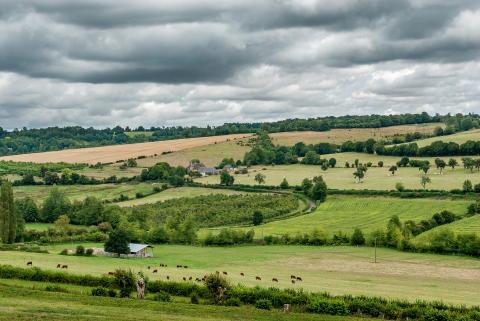
Biological control: how the landscape context affects the dynamics of pests and their natural enemies
Researchers from various laboratories at Université Paris-Saclay have used a modelling approach to study the interplay between landscape structure and the dynamics of pest control by natural enemies, and the impact of these interactions. Their findings provide valuable information for the elaboration of agroecological pest suppression strategies.
To what extent does the presence of thickets, hedges, meadows and other semi-natural habitats around crop cells influence their yield, and how is this related to the interactions between crop pests and their natural enemies? To answer these questions, numerical modelling experiments have been conducted by Antoine Le Gal and his colleagues at the Ecology, Systematics and Evolution laboratories (ESE - Université Paris-Saclay, CNRS, AgroParisTech), Functional ecology and ecotoxicology of agroecosystems (ECOSYS - Université Paris-Saclay, INRAE, AgroParisTech) and Sciences for action and development: activities, products, territories (SADAPT - Université Paris-Saclay, INRAE, AgroParisTech). Their findings highlight the importance of the landscape structure on the effectiveness of conservation biological control. In their model, increasing the proportion of semi-natural habitats in an agricultural landscape reduces the impact of pests on yield. It leads to a higher proportion of crop cells colonised by pests and then controlled by their natural enemies; in addition, these enemies are quicker to arrive at the cells, thus limiting the harm done by the pests. However, this control strategy does entail a trade-off with the production objective, since it requires the conversion of productive crop areas to semi-natural habitats.
The challenge of understanding conservation biological control
Pest control has always been a major issue for the agricultural sector. Insecticides have long been used as a means of addressing this problem. While this remains a widespread practice, a better understanding of its impacts on human health and the environment is now calling insecticide use into question. New agroecological solutions are emerging, many of them based on the principle of conservation biological control: that is, promoting pest suppression by natural enemies. Such a strategy involves converting a certain amount of agricultural area into semi-natural habitats. These habitats play an important role in the life cycle of many natural enemies of crop pests, by providing them with breeding sites for instance, or overwintering sites. However, the results obtained by empirical studies are still not well understood and there remains much to learn about the mechanisms involved.
In their recent work, Antoine Le Gal and his colleagues examine the influence of temporality - the reaction time of natural enemies, for instance, or the age of the plant when pests arrive - in the relation between the agricultural landscape structure and successful biological control. The studies show that temporality plays a crucial role in effective pest control and the reduction of crop yield losses. The times of sowing, parasite colonisation and arrival of the first natural enemies are all key factors in parasite suppression and crop yield.
Ladybugs versus aphids, wheat fields as modelling field
In their models, the landscape designed by the researchers includes cells both of forest patches and of annual crops such as winter wheat. The model considers that these crop cells are attacked by aphids, which are then suppressed by ladybugs, major natural enemies of the aphids. The simulations vary the total area converted to semi-natural habitats at landscape scale, to determine how this factor influences the effectiveness of biological control. The effectiveness of biological control is defined using the rate at which cells are cultivated, then colonised and controlled at the end of the annual campaign, and the average yield losses on a crop cell.
The study found that the visitation rate – in other words, the proportion of crops colonised by aphids and visited by ladybugs – vastly increases in proportion to the quantity of semi-natural habitats present around the crops. One of the scenarios, for instance, considers the "random" movement of ladybugs: in this scenario, they move around without using information on their immediate environment. In such a case, for all crop cells colonised by aphids to be controlled by ladybugs, at least 50 % of the landscape must be covered with semi-natural habitats. However, to bring average yield losses to an acceptable level, a much higher proportion of such habitats is required.
More knowledge needs to be acquired on the ecology of pests and their natural enemies, and on their relationship to crop yield losses, in order to develop new types of agricultural landscapes. These landscapes will advance conservation biological control strategies and be compatible with agroecological management. They will protect the environment and human health while producing enough food to sustain both the farmers and the population.
Reference: Le Gal, A. et al., Modelling the interactions between landscape structure and spatio-temporal dynamics of pest natural enemies:Implications for conservation biological control. Ecological Modeling, Vol. 420, March 2020.
